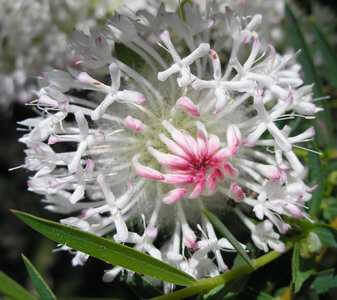So far this month I have reviewed the Pimelea ferruginea, the Pimelea physodes and the Pimelea rosea. Here is the final Pimelea variety for February.
More...
Pimelea spectabilis Features
Genus: Pimelea
Species: P. spectabilis
Family: Thymelaeaceae
Common Name: Bunjong
Flower Colour: Pink
Foliage Colour: Green
Growth Habit: Shrub to 1m
Flowering: Winter – Spring

Once again we have a variety of Pimelea that is clearly defined by its flower. The Pimelea spectabilis is quite different to the other varieties of Pimelea that I have reviewed.
The flower consists of an outer halo of mostly white flowers circling an inner white cluster with a deep pink centre. The leaves of the Pimelea spectabilis are a lot more pointy and indeed prickly but this should not deter you from planting this fantastic shrub.
Growing Pimelea spectabilis
The Pimelea spectabilis is very similar to the other varieties in that it likes a sunny to part shade position in the garden and prefers soil with good drainage.
This Pimelea species is endemic to the South-West of Western Australia, my home area, but in recent years has very much been taking of Australia wide and is available from a lot more nurseries than previously.
Pruning Pimelea spectabilis
Once it reaches its full size, Pimelea spectabilis is pretty much self-managing, but if you’re trying to keep it to a more limited size, regular pruning is necessary. Within its main dome, it will have plenty of old wood. This will not regrow new foliage, so it’s essential that any pruning is kept to the first few inches of growth, and never goes beyond green leaves.
Prune Pimelea spectabilis immediately after flowering. This will not only help to encourage new foliage but can even lead to a second flush of flowers in a mild year. Pimelea grows slowly in summer, so one prune each year will be enough to keep your Pimelea bushy and around the same size year after year.
Pruning overgrown Pimelea spectabilis
If your Pimelea has completely outgrown its space, the furthest you can realistically cut back with confidence is about 1/3 of the overall size (assuming there are leaves that deep into the shrub).
However, if it’s a choice between removing the plant entirely, and trying to save it from oblivion, it’s worth cutting right back to the ground. In some cases, this will trigger completely new shoots at the base.
It’s not guaranteed, and your plant may not recover, so this is a very last resort to try to whip an overgrown Pimelea back into shape.
Published on August 2, 2021 by Lorri Hopkins
Last Updated on February 26, 2024





Can you please give me some advice on the pruning of Pimelea Spectabilis. When, how severe, how often etc
Hi Andrew,
Thanks for your questions. We have updated the post with a pruning section. Is there anything else you would like to know?
Best regards,
Gary Clarke